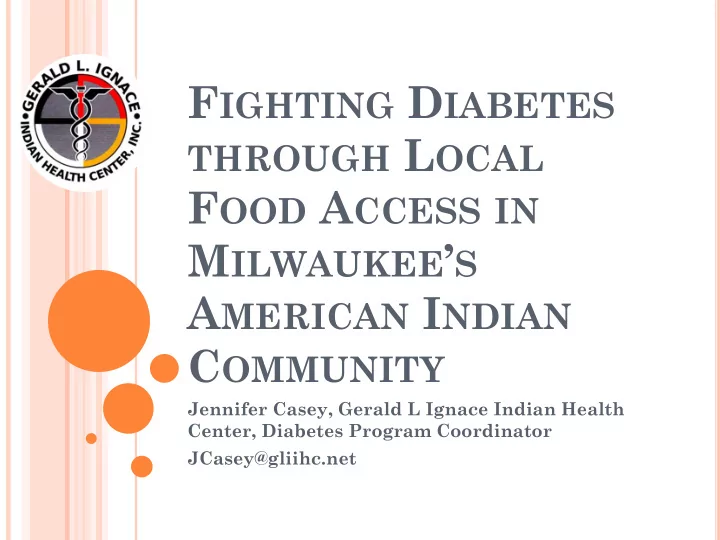

F IGHTING D IABETES THROUGH L OCAL F OOD A CCESS IN M ILWAUKEE ’ S A MERICAN I NDIAN C OMMUNITY Jennifer Casey, Gerald L Ignace Indian Health Center, Diabetes Program Coordinator JCasey@gliihc.net
www.gliihc.net
UI UIHO HO (IH (IHS) S) GLIIHC’s Mission: To impr o improve th e the e he health alth, , pe peac ace e an and d welf elfar are of e of Mil Milwau aukee ee's 's urb urban an In Indian dian Commu Community nity. . Medical, Medical, beha behavior vioral, al, social social & & cultur cultural al ser services vices MKE: MKE: ~15%, ~15%, or or 13,729, of WI’s AI’s.
T OXIC E NVIRONMENT Diabetogenic Obesogenic Dr David Kessler former FDA Commissioner and author of The End of Overeating says, “Unless we dramatically change our relationship with food, including the environment ..” ...the epidemic of obesity will go unresolved.
**Type 2 Diabetes can be prevented and controlled.**
C OMMUNITY O UTREACH & A DVOCACY Socio-Economic Health is about more than Model of Health individual behaviors & healthcare. Also about: Jobs Schools Neighborhoods Policies Government Laws… All layers of influence affect available choices, impacting our health and interacting with our genetics.
LIVE LEARN WORK PLAY
GLIIHC’ S C OMMUNITY A DVOCACY & O UTREACH FUNDING Diabetes Community Advocacy Best Practice Goal: Increase the number of people in the community who are aware of the ways to prevent and control diabetes R acial & E thnic A pproaches to C ommunity H ealth . Goal — decrease T2D and CVD (health disparities) among urban AI/AN population by addressing risk factors for DM and CAD, specifically nutrition, PA & weight.
O NGOING C OMMUNITY N EEDS A SSESSMENTS Community member surveys Listening forums Key Leader interviews Data Scans Mapping
O NGOING C OMMUNITY N EEDS A SSESSMENTS Some Key Findings: ~55% report inability to afford food 77% report limited or lack of access to traditional foods 29% of AI’s in Milwaukee receive food assistance. Only 3 MKE farmers markets accept SNAP benefits. 53204=“Food Swamp”
C OMMUNITY I NPUT What would help Milwaukee’s American Indian Community fight Type 2 Diabetes?” “Special food Pantry” “Have a conference/summit” “Education, education, more education…in homes, schools, community centers” “Outreach, information on where to purchase healthy foods, exercise classes, cooking classes, prevention should be geared towards children educating about healthy eating habits. “ “An indigenous restaurant with a healthy menu...or maybe something like a small organic/indigenous co-op with a counter and a few tables for dining and workshops on shopping, gardening, cooking, etc.” “Educational workshops, availability to healthier food including traditional foods, monetary assistance with purchasing / receiving healthy foods” “Awareness, education and access to healthier choices.” “Better access (transportation, location of markets, prices) to more traditional Native foods.”
C OMMUNITY A DVOCACY & O UTREACH P ARTNER S UPPORT /S TRUCTURE Milwaukee First Nations Health Coalition Mission : to work collaboratively with community partners to improve the health of Milwaukee’s American Indian community through health promotion and disease prevention education and strategies to make the places we live, work, learn, and play, more supportive of health.
GLIIHC’ S H EALTHY F OOD A CCESS Native Wellness Garden Mobile Markets (GP, SHARE, ITAC) Indian Summer Festival Increasing EBT at Farmers Markets Education/Promotion: Mino Ayaa Cooking Classes/WOLFE Library Native Community Wellness Event
GLIIHC’ S H EALTHY F OOD A CCESS : N ATIVE W ELLNESS G ARDEN
GLIIHC’ S H EALTHY F OOD A CCESS : N ATIVE W ELLNESS G ARDEN
GLIIHC’ S H EALTHY F OOD A CCESS : N ATIVE W ELLNESS G ARDEN
GLIIHC’ S H EALTHY F OOD A CCESS : N ATIVE W ELLNESS G ARDEN
GLIIHC’ S H EALTHY F OOD A CCESS : N ATIVE W ELLNESS G ARDEN
2014 G ARDEN E XPANSION Partnering with UW-EX allows us to: Dream Big! Plant more! 6000 sq feet will be room for more traditional foods, herbs, native plants and programming Food to be used in cooking classes and shared with community members Expand Programming! Space for education, ceremonies, art and gatherings Deeper connections with community partners (HoChunk, SEOTS, ICE, MPT, FNSMPS, Spotted Eagle) Connect elders & youth Develop future urban ag/workforce development programs.
GLIIHC’ S H EALTHY F OOD A CCESS : M OBILE M ARKETS
GLIIHC’ S H EALTHY F OOD A CCESS :
GLIIHC’ S H EALTHY F OOD A CCESS : EBT AT F ARMERS M ARKETS
GLIIHC’ S H EALTHY F OOD A CCESS : EBT AT F ARMERS M ARKETS
GLIIHC’ S H EALTHY F OOD A CCESS : E DUCATION /P ROMOTION : Mino Ayaa Cooking Classes Native Community Wellness Event
T HANK YOU ! Contact Info: Jennifer Casey, GLIIHC Diabetes & Community Health Coordinator (414) 383-9526 ext. 155 jcasey@gliihc.net www.gliihc.net
Recommend
More recommend